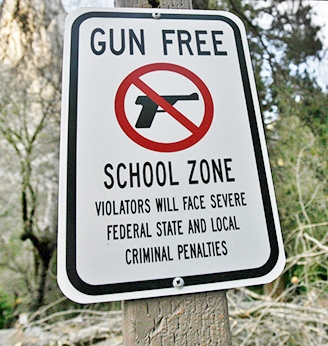Takeaway — Simple answer: Yes, less-lethal (impact, aerosol chemical, conducted energy) should be considered as a possible EDC adjunct to being armed. If you choose to carry less-lethal, get initial and periodic refresher training from a professional credentialed for the particular type/brand less-lethal weapon. Be prepared to articulate what you chose to carry (likely OC) and why. Update your knowledge base at least yearly for usage studies and legal developments, and to consider any product improvement. If you choose not to carry less-lethal, be prepared to articulate why not. Whichever way you go, expect that somebody, maybe someone whose opinion matters, will second guess you. Continue reading
Category Archives: Legal
CONSIDERATIONS FOR THE NON-SWORN : HOLDING SOMEONE “AT GUNPOINT”
 Executive summary: Usually a bad idea, often a very bad idea.
Executive summary: Usually a bad idea, often a very bad idea.
[This is a follow on to prior posts, THREATENING DEADLY FORCE : MUSINGS ON “BRANDISHING” AND “WARNING” SHOTS, and “CASTLE” DEFENSE: WHAT CAN–MAY–SHOULD–MUST YOU DO]
“Can/should I hold someone at gunpoint?” A common question when the topic of guns and defensive use of deadly force is discussed. The questioner’s “gunpoint” hypothetical usually poses a home invasion, robbery attempt of the questioner, or “in progress” interdiction of someone committing a property crime, or a violent crime against the questioner or another person. The question is another one to which I respond with my smart aleck lawyer’s answer: “I don’t know, can/should you?” It lends itself to analysis similar to what I discussed in prior MSW posts on the use of deadly force — my paradigm:
CAN / MAY / SHOULD / MUST
For the purpose of this post, holding someone “at gunpoint” is not necessarily muzzling the threatened person(s), openly holding an exposed firearm in any specific “ready” position, or a mode of “display” permitted or prohibited by a state “brandishing” statute. I use the phrase here to mean the display of a firearm coupled with the express or implied threat that a failure to obey commands will result in the use of deadly force, that is, the gunpointer WILL shoot. (If unprivileged, usually considered a serious felony, such as an armed assault or assault with/by deadly weapon). Consider the following for your analysis of the SHOULD element of the paradigm. Continue reading
RENDERING AID TO POLICE : YEA OR NAY?
Recent stories where the non-sworn (usually referred to as a “citizen” or “civilian”) successfully assisted a police officer caused me to write this post. One “all’s well that ends well” scenario involved a man who took shots when he witnessed an in-progress armed robbery and believed a responding officer was in danger of being ambushed. The officer took cover and the robber was captured later. (See here and here). Another, a more common scenario, involved bystanders who helped subdue a subject who might have overpowered the officer. (See here). Similar stories and videos on topic pop up on TV news reports and officer interest websites from time to time. (See examples, here and here). As an MSW reader, you likely already know that being a “hero” aiding police is, like policing itself, dangerous business. Thus it is no surprise; not every “hero” comes through unscathed. (See here). Also not surprising; simply having a cup of java in public with an officer is not risk-free. (See here). Finally, would it not just plain suck to aid an officer . . . and then someone else gets the credit? (See here). Continue reading
Should I suppress for home defense?

“Sorry folks, the park is closed….Moose out front should have told you” John Candy-“National Lampoons Vacation”.
The words of John Candy’s character kind of sum up my advice on the most of the “should I do XYZ for my home defense gun”. The fact is I only give advice on suppressors for home defense because there are thousands of variables. I can’t say with any kind of authority what might be right for your situation. Using suppressors doesn’t seem to be a one sized fits all. Juries and prosecutors might view a suppressed rifle in a deadly force incident one way in one location, and another way some place else. What I can do is give some things to think about, and the individual can decide for themselves based upon their situation and their needs. Continue reading
THREATENING DEADLY FORCE : MUSINGS ON “BRANDISHING” AND “WARNING” SHOTS

I “learned” the following while browsing the internet:
- In order to scare off a home intruder and alert neighbors to summon the police, one should go out to a balcony and fire a double-barreled shotgun into the air. WRONG: Likely tactical error abandoning a safer ensconced defensive position, misuse of limited ammunition supply, endangers others, and probably an unlawful discharge. Continue reading
“IMMUNITY” FROM CIVIL SUIT AFTER LAWFUL USE OF DEFENSIVE FORCE : FACT OR FICTION?
Critics of “Stand Your Ground” (SYG) laws often claim such laws improperly grant the user of defensive force “immunity” from a civil lawsuit for damages. They sometimes also argue that the “immunity” is better than that given to LEOs. Neither has yet been shown to be fact. I doubt either will ever be the general rule. In fact, a state’s “immunity” provision may actually have no relationship to its SYG law.
State “immunity” statutes relating to the use of force are of recent origin and thus, are not yet widely-interpreted by court decisions. The unanswered questions of interpretation can be rather complicated, but they do not present novel legal concepts. To separate fact from fiction, I “poked around” (a Georgia term for research) some state statutes. States with statutory provisions which bar civil recovery for damages against a user of reasonable or lawful force include (in no particular order): Georgia, New Hampshire, Michigan, Idaho, Ohio, Pennsylvania, Florida, Colorado, Maryland, Wyoming, Wisconsin, Texas, Mississippi, Kansas, New Jersey, Iowa, and Missouri.
Fact is, a state “immunity” law related to use of force may: Continue reading
SUPREME COURT RULES ON ATF FORM 4473 : WHO IS THE “ACTUAL TRANSFEREE/BUYER”
 In a prior MSW post I noted that the Supreme Court had agreed to hear what most refer to as a “straw” purchase criminal appeal (Abramski v. United States), see — “LEGAL NEWS FLASH: Supreme Court to Wade Into “Straw” Purchase Morass.” [For detailed history and discussion of the case, from Cornell University Law School’s Legal Information Institute, go here. You can listen to the argument before the Justices (here) or read a transcript here. An 18-minute audio containing an informative explanation of the case (from The Federalist Society) is here.
In a prior MSW post I noted that the Supreme Court had agreed to hear what most refer to as a “straw” purchase criminal appeal (Abramski v. United States), see — “LEGAL NEWS FLASH: Supreme Court to Wade Into “Straw” Purchase Morass.” [For detailed history and discussion of the case, from Cornell University Law School’s Legal Information Institute, go here. You can listen to the argument before the Justices (here) or read a transcript here. An 18-minute audio containing an informative explanation of the case (from The Federalist Society) is here.
As is often the case, oral argument provided little insight into the disposition which would earn the agreement of a majority of the Justices. Speculation on the decision is no longer necessary — the Court ruled on Monday, June 16. It held that a “misrepresentation” on Form 4473 is a crime (as if a “straw” purchase), even when the “true buyer” could have lawfully purchased a firearm. The rationale of the Court’s holding moved away from applying a criminal statute by its words (the preferred mode of analysis) to divining the statute by its and related provisions “structure, history, and purpose.”
The case is not a Second Amendment case. The majority’s thinking is not without arguable merit: If you are buying a gun “on behalf of” or as “an agent for” another, that person is the “actual transferee/buyer” for the purposes of the federal law under which the Form 4473 was promulgated. The “guy at the counter” is not. [Note: A March 2014 lower appellate court opinion (in an unrelated case) ruled similarly, holding that: “Under Form 4473, a person is not the “actual buyer” if the person acquires a firearm for another, even if the person actually pays for the firearm. Rather, the “actual buyer” is the person the firearm ultimately is for”].
Here are the “lessons learned” to take from the drama that is Abramski: Continue reading
SOME PERSPECTIVE ON SHOT COUNT & PLACEMENT, RELOADS, REENGAGEMENT
A tactically appropriate, legally acceptable deadly force response doesn’t necessarily “look right.” Imagine a courtroom (an LEO is being sued under Federal law for “excessive force,” or a non-sworn alleging self-defense is being prosecuted for murder or manslaughter), where you hear some or all of this: “Members of the jury. You heard from several eyewitnesses in this case. They uniformly told you they observed the defendant shoot the victim X times . . look around as if to see if anyone was watching, and then duck behind a wall . . . stash the partially empty pistol magazine . . . put a fresh one into the pistol . . . and reengage the wounded and flailing victim with Y additional shot(s) to the (body part) .” A bit concerned that even with the extensive explanation of experts, the above would seem excessive (shot count), unreasonable (reloading, reengaging), and/or sinister (scanning, taking cover) to a judge or jury? Even when the shooting is unquestionably “good”? I am. Continue reading
BEHOLD THE FEDERAL LAW : A PRIMER ON GUNS AND “SCHOOL ZONES”
 I write this post as a result of reading a recent news story about a parent in New Hampshire carrying a concealed handgun while waiting near a school to pick up his child (story here). From that story: “A federal law, Gun-Free Schools Zone Act, prohibits people from carrying a loaded gun, even if that person is properly licensed, within 1,000 feet of a public or parochial school.” Nope, not the law. Continue reading
I write this post as a result of reading a recent news story about a parent in New Hampshire carrying a concealed handgun while waiting near a school to pick up his child (story here). From that story: “A federal law, Gun-Free Schools Zone Act, prohibits people from carrying a loaded gun, even if that person is properly licensed, within 1,000 feet of a public or parochial school.” Nope, not the law. Continue reading
LEGAL RAMIFICATIONS OF HANDGUN MODIFICATIONS AND NON-FACTORY STANDARD REPLACEMENT PARTS
Do an internet search of the first five words of this post’s title. You will get enough distinct hits for days of reading, as a hundred or more (in the first thousand or so) appear to contain substantive material worthy of consideration. In short, longstanding advice — from homicide investigators, prosecutors, defense lawyers, gun writers, bloggers, the self-defense firearms community, and those who actually consult and testify as experts in criminal and civil trials — urges (prudently) leaving a defensive handgun factory box stock, to avoid adverse consequences in a legal proceeding. Critics of such advice note (correctly) a near dearth of anecdotal trial reports and published appellate decisions suggesting there are adverse legal ramifications on account of modification to or installation of a non-factory standard replacement part (NFSRP) into a defensive handgun. So, are there legal ramifications or not? Yes, there can be. Are they adverse? Perhaps. Should one then automatically forgo a useful, desirable, and common handgun modification or NFSRP? Probably not. Continue reading
MAY/MUST Questions Answered Correctly. . . Shoot First, Live
There is a saying (often attributed to Clint Smith of Thunder Ranch): “Some people just need to be shot.” Taking a life is the last thing anybody wants to do, whether in public service as an LEO, or as an unsworn in defense of self or innocent others. But wise and healthy aversion to the awful, distasteful, life-changing (but sometimes necessary) deed does not render that statement silly or merely theoretical, legally or tactically. Continue reading
NICE KNIFE . . . BUT IS IT LEGAL?
I used to cut out magazine articles and advertisements from in flight magazines with a large pocket knife in full view of other passengers and the airliner’s crew. That was decades ago. Pocket knives are no longer considered a gentleman’s tool; they are weapons subject to detailed criminal laws.
Ask someone who regularly carries a handgun about their home state’s law on open or concealed carry, about the law of a neighboring state, or the law in states where they travel regularly. They likely know the law fairly well. Now, ask them about the folding knife hiding behind their exposed pocket clip. It is likely they either do not know their state’s law on knifes, or if they know something, it is incorrect or incomplete. LEOs believe (mostly incorrectly) that some Federal or state law exempts them from limitations applicable to ordinary citizens.
Knife laws vary state to state, and can be more complicated than one might suspect. Federal law on domestic or imported automatic-opening (commonly referred to as “switchblade”) knives? Less likely to be known correctly. How about fixed knives carried on the belt in a sheath? Carrying a knife on an Indian reservation? On Federal land other than the District of Columbia? Blades concealed in belt buckle or otherwise disguised? Carry based on a concealed weapon/firearm permit/license? In a reciprocity state? When in interstate travel? Continue reading
LEGAL NEWS FLASH: Supreme Court to Wade Into “Straw” Purchase Morass
Ever buy a gun for someone else (a friend or relative who is lawfully allowed to own firearms)? Maybe as a favor because you are at a gun show they could not attend, you have a Gunbroker account and they do not, or because you get a LEO or other discounted price? Tread lightly, you might wind up “breaking bad.” A criminal conviction in one such case will be reviewed by the U.S. Supreme Court. Review was granted by order of October 15, 2013. Expect the court’s opinion in the Spring of 2014. (Abramski v. United States, Docket No. 12-1493).










